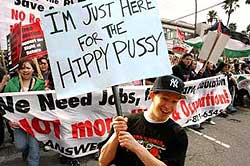How did it work? The same way that boxer Muhammad Ali fought his opponents in the past: rope-a-dope.
Defense Secretary Rumfeld’s small-footprint force-protection strategy (to mimimize casualties) meant that Al Qaeda In Iraq couldn’t attack American troops without getting immediately annihilated.The enemy understood the risks: that playing for a "Tet Offensive Revisited" media victory would cost them the war on the ground. This is clear in the letter that al Qaeda #2, Ayman al-Zawahiri, wrote to al Qaeda in Iraq leader Abu Musab al-Zarqawi in the Fall of 2005:
In order to get the “continuing violence” that their allies in the Western media could use to create American defeat on the home front, the Saudi and Iranian proxy warriors in Iraq had no choice but to wage war on the Iraqi people.
"The policy followed by the brothers in Baghdad is a media oriented policy without a clear comprehensive plan to capture an area or an enemy center. (In) Other word(s), the significance of the strategy of their work is to show in the media that the American and the government do not control the situation and there is resistance against them. This policy dragged us to the type of operations that are attracted to the media, and we go to the streets from time to time for more possible noisy operations which follow the same direction.
This direction has large positive effects; however, being preoccupied with it alone delays more important operations such as taking control of some areas, … That is why every year is worse than the previous year as far as the Mujahidin’s control and influence over Baghdad."
[From the CENTCOM translation of Zawahiri's letter, May 2006, not identified as coming from Zawahiri, but containing much language in common with the captured Zawahiri letter that was released to the public in October 2005]
And so it was settled. Al Qaeda’s would attack Iraqis, creating media events that the Western media could use to try to lose the war at home. It was understood that this strategy would turn the Iraqis against al Qaeda, losing the war on the ground, but maybe not before the Democrats and their media allies managed to lose the war in America. It would be a race: could the Democrat/ al Qaeda alliance create defeat in America before the American military would win the war in Iraq?Now it is true that General Petraeus has changed the strategy. But Petraeus' new more aggressive strategy not only puts our troops at greater risk, it also relies upon Rumsfeld's timing:
This has been par for the course for four years. The media knows as well as al Qaeda that this is a race, and it looks now that the race has been won by our military, thanks to the switch to a more aggressive finishing strategy orchestrated by General Petraeus. What has allowed the “surge” strategy to succeed so spectacularly is the Iraqi people’s almost unanimous hatred for al Qaeda, created by the Democrat/ al Qaeda media strategy of blowing up Iraqis. This turn against al Qaeda was fully formed during Rumsfeld’s tenure. To make use of that hatred, all Petraeus had to do was switch from force protection to population protection. Protected from retaliation, Iraqis expressed their hatred of al Qaeda by pointing to the bad guys.
Should we have used the Petraeus strategy from the outset? That’s a little like seeing Ali come off the ropes in the 8th round to "KO" Foreman and thinking: “hey, he should have done that in round one.” Petraeus’ “clear, hold and build” strategy might have worked earlier, but it also might have altered al Qaeda’s strategy. If our troops had been more exposed, al Qaeda might have concentrated more on military targets and less on the Iraqi population, which was the key decision that determined everything. Induce al Qaeda to make a different decision, and who knows how things might have turned out?Thanks to Alec Rawls at Error Theory.











No comments:
Post a Comment